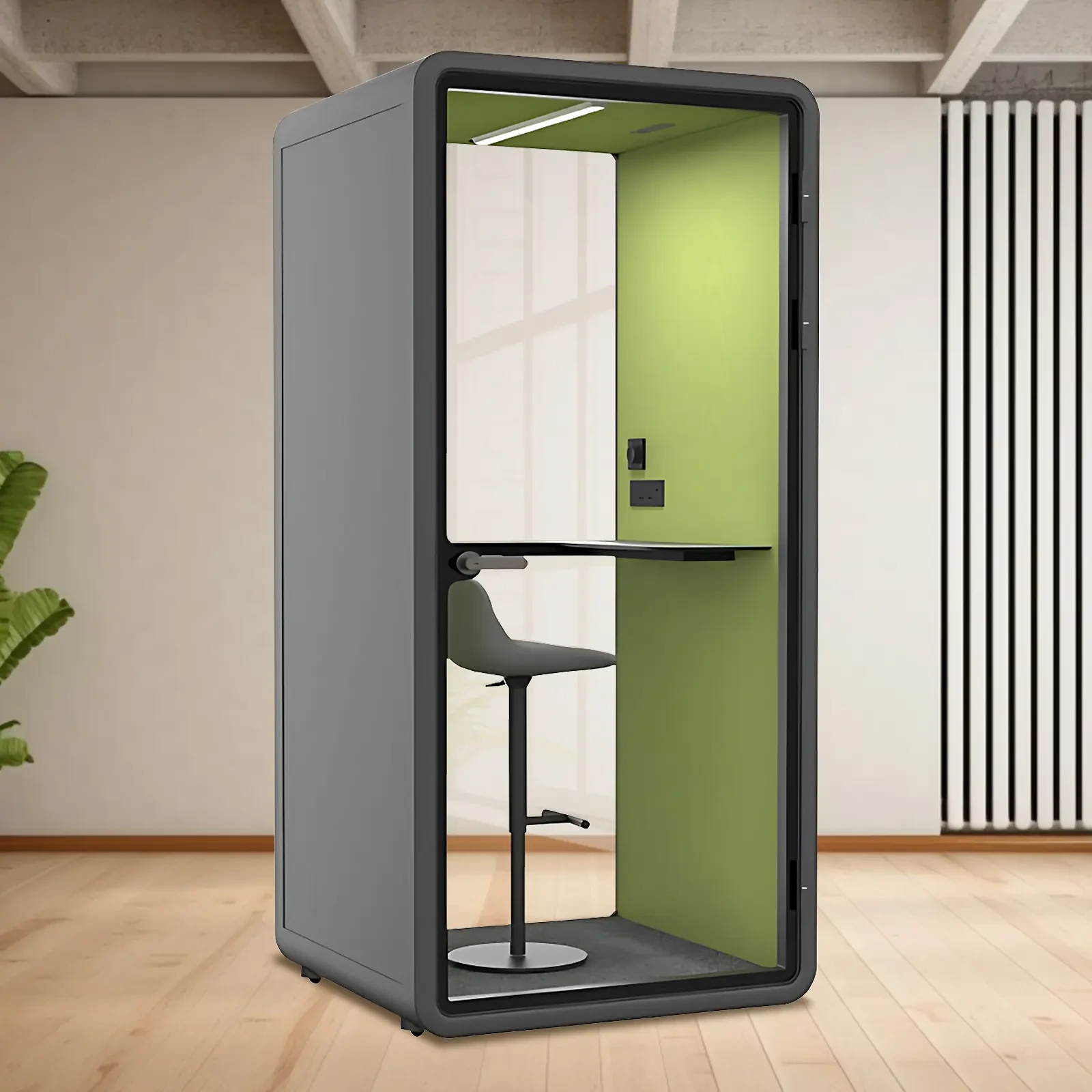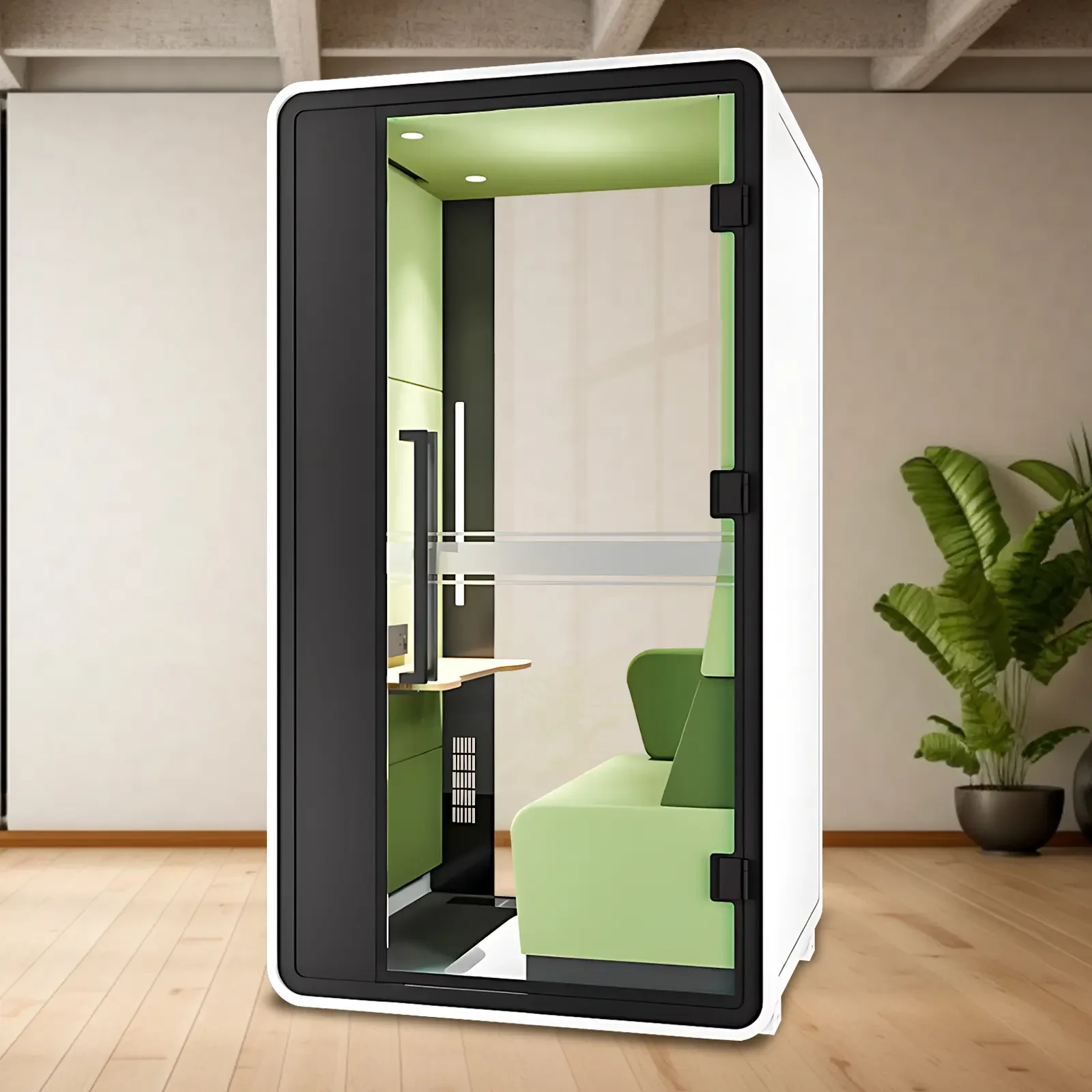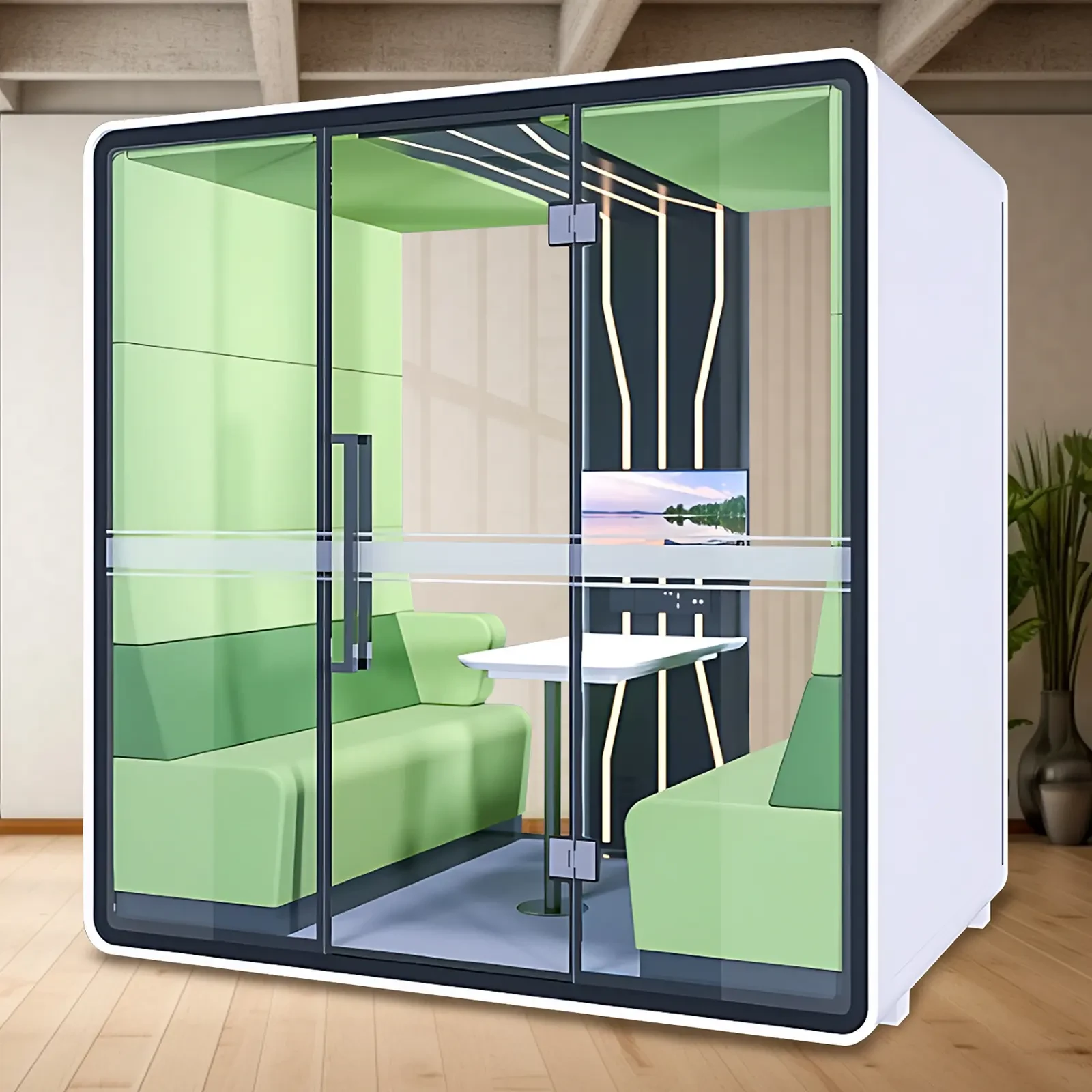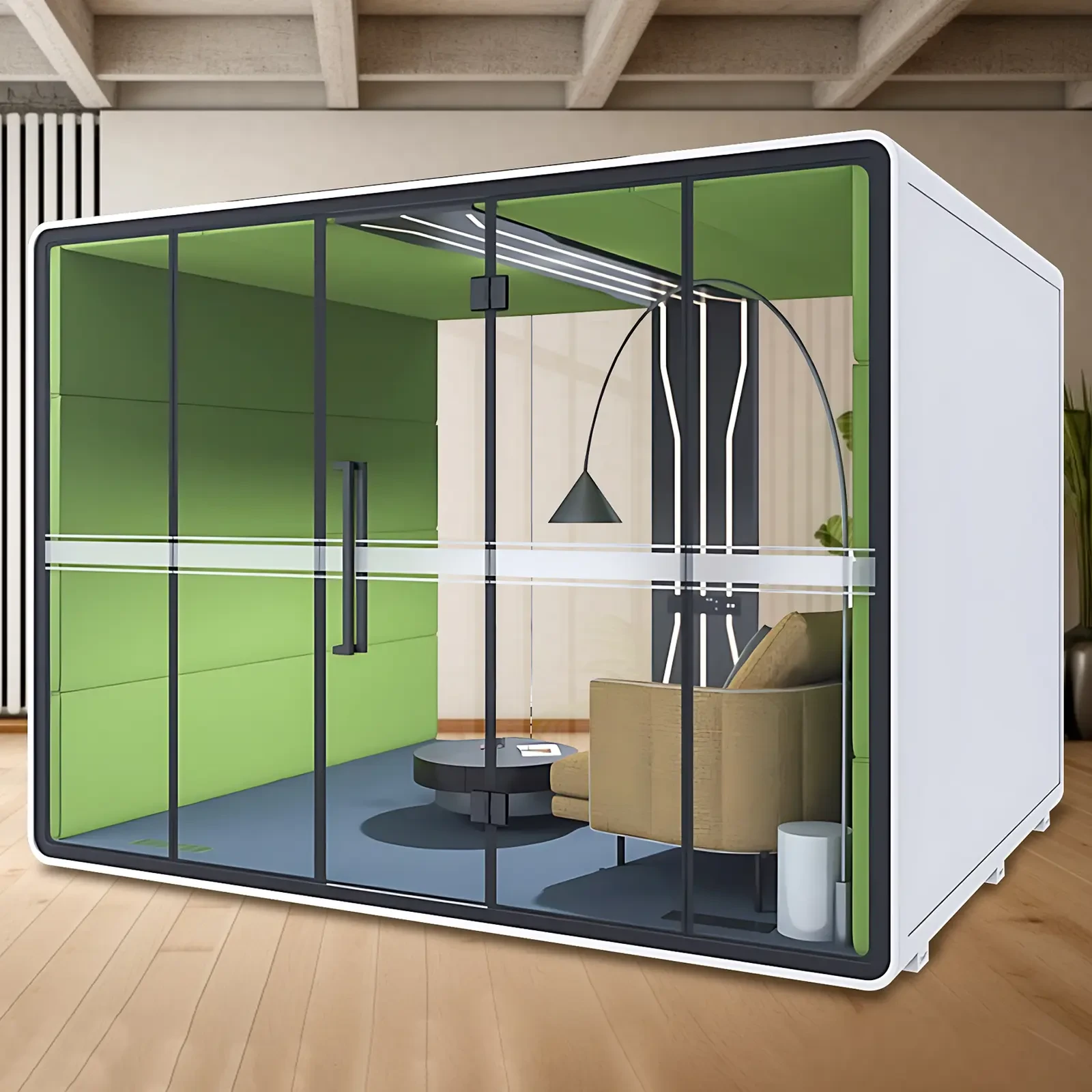Introduction: In this bustling, noisy world, noise is ever-present, constantly disrupting our lives and work. In open offices, the cacophony of colleagues' discussions, keyboard tapping, and phone calls can make it difficult to concentrate. At home, traffic noise and construction noise outside the window disrupt the otherwise peaceful tranquility. In these situations, a silent cabin offers a tranquil haven, shielding us from the clamor of the outside world and providing a private, quiet space.
A silent cabin is typically a standalone structure, placed in a corner of an office or a home study. It's typically supported by a sturdy frame and constructed from specialized sound-insulating materials that effectively block sound transmission. The cabin's doors and windows are also crucial, often featuring multiple layers of soundproof glass and highly effective sealing strips to prevent sound from entering. Inside, you'll find sound-absorbing materials lining the interior, acting like a "sponge" to absorb residual sound, further reducing echo and noise disturbance. Imagine stepping into a silent cabin and gently closing the door. Instantly, the outside world is completely shut out, as if entering a whole new world. Here, you can focus on conference calls without worrying about external noise interrupting your train of thought. You can also quietly work on important documents, significantly improving your work efficiency. For creative workers, a quiet environment can inspire inspiration and allow your thoughts to flow freely. When studying, a silent cabin creates an immersive learning atmosphere, helping you absorb knowledge better. In daily life, it can also serve as a private space for relaxation and meditation.
The emergence of silent cabins not only meets people's urgent need for quiet spaces, but also adapts to the fast-paced and diversified development trends of modern society. As people's demands for quality of life and work efficiency continue to rise, the silent cabin industry is gradually emerging and showing great development potential.
Market Status Analysis
(I) Surging Demand, Broad Prospects
In recent years, the demand for silent cabins has shown rapid growth. With the increasing popularity of remote work, more and more people are working from home. However, home environments are not always quiet, and external noise interference seriously affects work efficiency. Quiet cabins provide remote workers with an independent, quiet workspace, allowing them to focus on their work without interruption.
At the same time, demand for quiet environments is also growing in public spaces, such as shared offices, libraries, and schools. In shared offices, different users have varying work needs and paces, and quiet cabins can meet their needs for privacy and quiet work. In libraries and schools, students need a quiet study environment, and quiet cabins can provide a positive learning atmosphere.
According to relevant market research reports, the global quiet cabin market has maintained steady growth over the past few years and is expected to continue expanding at a high rate in the coming years. This data clearly demonstrates the enormous potential and promising prospects of the quiet cabin market.
(II) Technological Advances and Functional Upgrades
With the continuous advancement of technology, quiet cabins have made significant technological advances. Researchers are constantly exploring and innovating in sound insulation materials, resulting in a continuous emergence of new types. For example, some quiet cabins utilize multi-layer composite sound insulation materials, combining the sound insulation advantages of different materials to more effectively block sound transmission. At the same time, sound-absorbing materials have also been upgraded. Through specialized designs and materials, they significantly enhance sound absorption and reduce cabin echoes.
In terms of smart device applications, today's silent cabins are becoming increasingly intelligent. Many are equipped with intelligent lighting systems that automatically adjust brightness and color temperature based on user needs, creating a comfortable lighting environment. Intelligent ventilation systems also ensure air circulation and maintain freshness within the cabin. Furthermore, some high-end silent cabins integrate intelligent conferencing equipment, such as high-definition cameras and microphone arrays, providing a convenient conferencing experience. These added features significantly enhance the user experience, making the silent cabin not only a quiet space but also a fully functional intelligent work and study space.
(3) Industry Chaos, Urgent Need for Regulation
Despite the rapid development of the silent cabin market, many issues remain within the industry. Due to the low market entry threshold, some small manufacturers cut corners in the production process to reduce costs. They use substandard sound insulation materials, significantly compromising the cabin's soundproofing effectiveness. Some silent cabins also have sealing issues, allowing sound to easily penetrate through gaps.
Furthermore, some manufacturers exaggerate their product promotions, falsely advertising the performance of their silent cabins and misleading consumers. The influx of these products of varying quality into the market not only harms consumers but also negatively impacts the reputation of the entire industry. This long-term trend will hinder the healthy development of the industry, and therefore, industry regulations urgently need to be strengthened.
(IV) Intensified Competition and Emerging Market Structure
As the potential of the silent cabin market is gradually tapped, more and more potential entrants are entering the industry. In addition to professional office furniture manufacturers entering the silent cabin market, some technology companies are also entering the fray, leveraging their technological advantages.
Globally, several major manufacturers have emerged. For example, the foreign brand [Brand 1], with its advanced soundproofing technology and high-end design, has captured a significant market share in Europe and the United States. The domestic brand [Brand 2], with its cost-effectiveness and localized service, has won widespread customer support in the domestic market. Currently, the market share is relatively fragmented, but as competition intensifies, the advantages of leading companies are gradually emerging, and a market structure is beginning to take shape. Major manufacturers are increasing their R&D investment, improving product quality and performance, and competing through differentiated approaches to gain a larger market share. Diverse Application Scenarios
(I) Office Scenarios: The Secret Weapon for Efficient Focus
Noise chambers are playing an increasingly important role in the office. In open offices, a variety of noises can severely impact employee productivity and focus. Noise chambers provide employees with a separate, quiet workspace where they can conduct conference calls, write important documents, and engage in deep thought.
For example, in some internet companies, project teams frequently engage in brainstorming and discussion. Noise chambers provide a distraction-free environment, allowing team members to speak freely, spark creativity, and improve collaboration efficiency. Furthermore, for employees who need to communicate remotely, noise chambers effectively prevent external noise interference, ensuring the quality and effectiveness of communication.
(II) Education: Quiet Corners for Learning
Noise chambers are also widely used in the education sector. School libraries and study rooms are often overcrowded, making noise unavoidable and impacting student learning outcomes. Noise chambers provide students with a quiet study corner where they can focus on reviewing homework, preparing for exams, and engaging in group discussions. In some training institutions, teachers also use silent cabins for one-on-one tutoring or online teaching, ensuring that the teaching process is free from external interference and improving teaching quality. Furthermore, for students who need to learn languages or practice listening, the quiet environment of silent cabins can better meet their learning needs and enhance learning outcomes.
(III) Healthcare and Health: A Quiet Space for Healing
Silent cabins also have important applications in the healthcare and health sectors. In counseling rooms, silent cabins provide a quiet and private space for patients and counselors, allowing them to more relaxedly share their inner concerns and counselors to more focusedly provide support, thus enhancing the effectiveness of counseling.
In hospital rest areas, silent cabins allow patients who need a quiet environment to recover and rest, away from the hustle and bustle of the hospital. Furthermore, some rehabilitation treatment rooms have also introduced silent cabins, creating a quiet treatment environment for patients, helping them better cooperate with treatment and promote physical recovery.
(IV) Entertainment and Creativity: A Dedicated Space for Inspiration
Silent cabins are indispensable for the entertainment and creative industries. In recording studios, soundproofing booths isolate external noise, ensuring clear and pure audio quality. Singers can unleash their talents without interruption, producing high-quality music.
In livestreams, streamers use soundproofing booths to create a professional livestream environment, preventing external noise from disrupting their broadcasts and enhancing the audience's viewing experience. In music studios, film and television post-production studios, and other venues, soundproofing booths can also provide a quiet space for creators to inspire and unleash their creativity.
Future Development Trend Insights
(I) Intelligence: Opening a New Chapter in Convenient Living
Amidst the rapid advancement of technology, intelligence has become a key development direction for soundproofing booths. Future soundproofing booths will be equipped with advanced intelligent control systems, acting like attentive butlers, providing users with comprehensive and convenient services.
Using smart sensors, soundproofing booths monitor environmental parameters such as temperature, humidity, and air quality in real time and automatically adjust them. If the temperature is too high, the system automatically activates the air conditioner for cooling; if the humidity is unsuitable, it activates a humidifier or dehumidifier to adjust the temperature. When air quality is poor, the air purification system quickly activates to ensure the cabin's air is always fresh and pleasant.
Smart lighting systems will also become even more intelligent, automatically adjusting the brightness, color, and mode of the lights according to different scenarios and user needs. Bright, clear light is provided during work, enhancing productivity; while soft, warm lighting is switched to create a comfortable atmosphere for relaxation. Furthermore, the system can connect with the user's smart device for remote control. Users can reserve a quiet cabin and set the cabin's environmental parameters in advance via their mobile phone while commuting to work, ensuring a comfortable, quiet space is ready upon arrival.
(II) Flexible Modularity: Adapting to Changing Space Needs
To meet the diverse needs of different scenarios and users, flexible modular design will become a major development trend in quiet cabins. Future quiet cabins will adopt a modular structure, like building blocks, allowing for flexible assembly and disassembly according to specific needs.
In office settings, when a company needs to hold a large meeting, multiple small quiet cabins can be combined to form a large meeting space; during daily work, these cabins can be disassembled to provide employees with independent workspaces. In public places such as airports and train stations, the number and layout of silent cabins can be flexibly adjusted based on passenger flow.
This flexible, modular design not only improves space utilization but also reduces costs. Users can choose silent cabins with different functional modules to meet their specific needs, such as conference cabins equipped with multimedia equipment or rest cabins with comfortable reclining chairs.
(III) Environmental Protection and Sustainability: Practicing the Concept of Green Development
With increasing environmental awareness, environmental protection and sustainability have become inevitable requirements for the development of various industries, and the silent cabin industry is no exception. In the future, silent cabins will place greater emphasis on the use of environmentally friendly materials to reduce their environmental impact.
In terms of material selection, renewable and recyclable materials, such as recycled metals and biodegradable plastics, will be widely used. Sound insulation materials will also be developed in an environmentally friendly direction, using new, non-toxic, odorless, and pollution-free materials to not only effectively isolate sound but also protect the health of users. Furthermore, during the production process, processes will be optimized to reduce energy consumption and waste emissions.
Silent cabins using environmentally friendly materials not only meet social environmental requirements but also enhance the social image of companies. For users, choosing an environmentally friendly silent cabin also contributes to environmental protection, achieving a win-win situation for both economic and environmental benefits.
(IV) Multifunctionality: Expanding the Boundaries of Infinite Possibilities
Beyond existing applications such as office, study, medical care, and entertainment, the functions of silent cabins will be further expanded in the future, developing towards multifunctionality.
In the social realm, silent cabins can be transformed into private social spaces where friends can gather and chat without being disturbed. For leisure, silent cabins equipped with massage equipment and sound systems can become places for people to relax and enjoy music. Even in the commercial sector, silent cabins can serve as small exhibition spaces, livestreaming studios, and other facilities to meet diverse business needs.
As people's demands for quality of life and space efficiency continue to rise, multifunctional silent cabins will bring more surprises and conveniences, creating more possibilities.
Summary and Outlook
The silent cabin industry is experiencing a period of rapid growth. Driven by addressing people's urgent need for quiet spaces, it has rapidly gained market share. While the industry currently faces challenges, such as the need for improved industry standards and fierce market competition, the continuous advancement of technology and the innovative development of silent cabins in terms of functionality, design, and environmental friendliness paint a promising picture for their future.
Not only do they bring numerous conveniences to our work and lives, improving efficiency and quality, they also play a key role in diverse fields, from enhancing office efficiency to supporting education and teaching, from improving the medical experience to inspiring creative inspiration. We believe that with the continued development of the silent cabin industry, it will become even more deeply integrated into our lives, becoming an indispensable part. Let us all look forward to more surprises and innovations in the silent cabin industry, creating a quieter, more comfortable, and more efficient living and working environment. If you haven't experienced a silent cabin yet, consider giving it a try; it may bring you unexpected benefits.

 USD
USD
 GBP
GBP
 EUR
EUR






